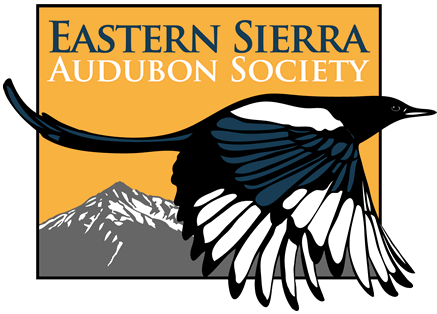“Hogwash!” declared the chipmunk lady.
“It’s true, Enid.” reaffirmed Tom.
quot;I don’t believe it!” she said, her blue eyes flashing.
“But Enid, some of the finest scientists of the day were on the expedition and if those birds were here they would have found them.”
“They were all around our ranch when I was a child, Tom, and I can’t believe that they weren’t always in the Owens Valley.”
The famous Enid Larson was in an unusual quandary as this new information did not align with what she knew about her beloved valley. The next day at the crack of dawn we heard a rat-tat-tat on the front door. We opened it to see Enid’s blue eyes twinkling and her impish smile warning that she was about to reveal another of her wonderful stories. “I was scared to death that I was going to die last night before I solved the magpie problem. If St. Peter had asked me, ‘O.K., Enid, what is the full story on the Black-billed Magpie in the Owens Valley?’ I would have had to admit that I didn’t know and that,” she chuckled, “would have killed me! So early this morning I called a really old friend of mine who has lived in the valley longer than I and asked if there had always been magpies in the valley. I was stunned when she said, ‘No, Enid. When I was a child there were none until the ranchers started planting locust trees as wind breaks. Then we started seeing the magpies building their big stick basket-nests.’ And here I thought they were always in the valley. Now I can answer St. Peter when he asks me!” Luckily for the valley and her friends it was another 20 years before she would have to answer him.
The aforementioned Death Valley Expedition of 1891, led by A. K. Fisher, was the first serious scientific investigation of Inyo county and included many parts of Inyo county besides Death Valley. It is fascinating and frustrating to read the report and see the changes man has caused over the last 100 years. Fulvous Whistling Ducks used to be common at Owens Lake. The only one seen in Inyo since Owens Lake became a shadow of its former glory was at Furnace Creek Ranch on 25 Sep 1973. Bell’s Vireos were common along the Owens River and now are completely extirpated from the valley. They never found any Screech Owls, now fairly common, nor the flashy, noisy and now common Black-billed Magpies of the above story.
Twenty years passed before Joseph Grinnell, from the University of California, Berkeley, began a series of annual trips to Death Valley which lasted through the thirties. He surveyed the birds found at or below sea level which in Death Valley is -282′. He commented on birds not found there that he felt “could exist in Death Valley”. Two that he mentioned, Lucy’s Warbler and Verdin, have since moved in and are now seen regularly in the mesquite where they breed.
Mr. M. French Gilman continued ornithological studies during the thirties while he was chief caretaker at Death Valley. He reported of having Black-billed Magpies daily from Nov 1933 to May 1934. Only a few were reported since then in Death Valley, and those were in the early seventies, with none seen or heard since.
U. C. Berkeley continued its interest in Inyo county during the thirties, forties & fifties but changed the area of study to the Owens Valley and the White Mountains. They sent out Alden Miller whose main purpose was to document the breeding birds but in doing so he found a male Blue-winged Warbler, a vagrant from the east. This was the first record of this species west of the Great Plains.
During the late fifties & sixties Roland Wauer, a naturalist with the US National Park Service, conducted studies of the birds of Death Valley and the Panamint Mountains. Along with important breeding information from the Panamints he found a Blackpoll, the first record for California and a Lawrence’s Goldfinch, the first record for the Panamints.
The Bureau of Land Management sponsored field work during the seventies which covered the Owens Valley and nearby mountain ranges. They used this work to help them in land use policy decisions.
Dr. Ned K. Johnson, from U. C. Berkeley, began conducting ornithological research in the White & Inyo Mountains in the 80’s and continues today. A recent publication of his deals with Sage Sparrows and the two different forms making contact in the Owens Valley.
Other on-going studies are the annual breeding bird surveys conducted by the U. S. Fish and Wildlife Service. Almost a dozen of these surveys are run every year in Inyo with Jan Tarble, volunteer extraordinaire of Tecopa, carrying out her surveys for over 20 years. This information, collated nationwide, helps keep a finger on the pulse of avian population dynamics.
One hundred years of research has yielded many answers but as Albert Einstein said, “As the area of light increases so too does the circumference of darkness.” As our knowledge expands so too does our ability to ask questions.
Tags: duck, finch, magpie, owl, sparrow, vireo, warbler, wren
